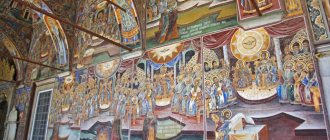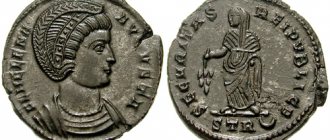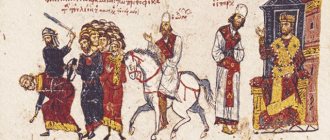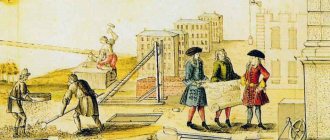For the “offended bishops,” the Arian disputes simply became a reason to assert themselves; they needed Arius only as a banner. Socrates Scholasticus notes that the rulers, carried away by politics, “caused the world even more trouble than before” - the Arian disputes flared up with renewed vigor...
Arius, 1493
The new adamant Bishop of Alexandria - Athanasius
We read about Bishop Athanasius in the book of Socrates Scholasticus: “Rufinus says that, while still a child, Athanasius and his peers were already playing a sacred game: it was an imitation of the priesthood and the class of initiates. In this game, Athanasius received the throne of the bishop, and of the other children, each represented either a presbyter or a deacon. The children repeated this game every time on the day when the memory of the martyrs and Bishop Peter was celebrated. At this time, the Alexandrian bishop Alexander, passing by, saw the children playing and, calling them to him, asked each of them which face each of them represented in the game, and from the game he tried to predict something about their characteristics. He also ordered to take these children to church and teach them, especially Athanasius. The latter, when he came of age, Alexander ordained him a deacon and took him with him to Nicaea as his assistant at the Council there.”
Saint Athanasius the Great
Bishop Athanasius, who will go down in history as St. Athanasius the Great, turned out to be as adamant as his predecessor at the Alexandrian see. Ermius Sozomen of Salamis talks about the disputes between Athanasius and Eusebius of Nicomedia: “First Eusebius wrote to him and in his letters tried to persuade him to accept the followers of Arius; If he did not obey, he threatened to do him harm in writing. But (Athanasius) did not agree to this, arguing that the inventors of heresy to distort the truth - people overthrown by the Council of Nicaea - cannot be accepted.” And all efforts to force Bishop Athanasius to accept Arius into his Church remained in vain.
The Bishop continued to insist: it is not right for the Orthodox to accept known heretics into fellowship. It became clear that Arius could only be returned to Alexandria if Bishop Athanasius was removed from Alexandria. The Arians again resorted to their favorite weapon - political intrigue.
Notes[ | ]
- French Wikipedia (French) - 2001.
- Arius // Brockhaus Encyclopedia (German)
- Arius // opac.vatlib.it (English)
- Arius // Catalog of the Unione Romana Biblioteche Scientifiche
- ↑ 12
https://link.springer.com/content/pdf/10.1007%2F1-4020-2238-7_7.pdf - ↑ 12
https://www.christopherlong.co.uk/pub/byzantium.html - ↑ 12
https://www.newtonproject.sussex.ac.uk/view/texts/normalized/THEM00117 - Torkington, David.
Wisdom from Franciscan Italy: The Primacy of Love: [English]. — John Hunt Publishing, 2011-02-03. - P. 113. - ISBN 9781846944420. - Anatolios, Khaled.
2. Development of Trinitarian Doctrine: A Model and Its Application // Retrieving Nicaea. - Grand Rapids: Baker Academic, 2011. - P. 44. - “Arius, born in Libya, was a respected ascetic and presbyter in the church of Baukali in Alexandria.” — ISBN 978-0801031328. - Aerians // Encyclopedic Dictionary of Brockhaus and Efron: in 86 volumes (82 volumes and 4 additional). - St. Petersburg, 1890-1907.
- Williams, Rowan.
Arius. — Revised. - Grand Rapids, Michigan: WB Eerdmans, 2002. - P. . — ISBN 0-8028-4969-5. - Constantine the Great Rules - National Geographic - Retrieved September 23, 2014.
- Hanson, R. P. C.
The Search for the Christian Doctrine of God. - Grand Rapids: Baker Academic, 2007. - P. 127–128. — ISBN 978-0-8010-3146-5. - Kopeck, M. R. (1985). “Neo Arian Religion: Evidence of the Apostolic Constitutions.” Arianism: Historical and Theological Reassessments
: 160-162. - Torkington, David. Wisdom from Franciscan Italy: The Primacy of Love. John Hunt Publishing, 2011, p. 113. ISBN 9781846944420.
- Bolotov, 2007, p. 48.
- Diamonds, 2007, p. 97-98.
- Kartashev, 1994, p. 18.
- Bolotov, 2007, p. 49.
- Archived copy (unspecified)
(inaccessible link). Date accessed: May 3, 2021. Archived September 6, 2021. - Irsai, 2011.
- Bolotov, 2007, p. 50.
- Diamonds, 2007, p. 101.
- Diamonds, 2007, p. 105-109.
- Diamonds, 2007, p. 110.
- Hanson, 2005, p. 146-151.
- Constantine the Great // Encyclopedic Dictionary of Brockhaus and Efron: in 86 volumes (82 volumes and 4 additional). - St. Petersburg, 1890-1907.
- Archpriest A. Schmeman. The era of Ecumenical Councils / The historical path of Orthodoxy
- "Church History", book. 1, ch. 5 “On the dispute between Arius and Bishop Alexander”
- Vasiliev, Al.
The empire from Constantine the Great to Justinian // History of the Byzantine Empire. — 1928. - Scrum, DS
Arian Reaction - Athanasius
(undefined)
.
Biography of Arius
. Access date: May 2, 2012. Archived March 3, 2012. - ↑ 1 2 Jones, A.H. M.
The Later Roman Empire, 284-602: A Social, Economic, and Administrative Survey.. - Baltimore: Johns Hopkins University Press, 1990. - P. 118. - ISBN 0-8018-3353- 1. - Second Creed of Sirmium or “The Blasphemy of Sirmium” (undefined)
.
www.fourthcentury.com
. Date accessed: March 9, 2021. - Freeman, Charles.
AD 381, Heretics, Pagans and the Dawn of the Monotheistic State. - Overlook Press. - Arianism, The Columbia Encyclopedia
, . Retrieved May 2, 2012. - Kritzeck, James.
Peter the Venerable and Islam. - Princeton, New Jersey: Princeton University Press, 2015. - P. 145–146. — ISBN 9780691624907. - Wilbur, Earl Morse.
The Socinian Exiles in East Prussia // A History of Unitarianism in Transylvania, England, and America. - Boston: Beacon Press, 1977. - Institute for Metaphysical Studies—The Arian Christian Bible—Metaphysical Institute, 2010. Page 209. Retrieved June 10, 2014.
- Adam Bourque - Ten Things You Didn't Know about Jehovah's Witnesses. Archived from the original on July 14, 2014.—Michigan Skeptics Association. Retrieved June 10, 2014.
- Dorsett, Tommy
Modern Day Arians: Who Are They?
(undefined)
. Access date: May 2, 2012. - Trinity: Arius and the Nicene Creed (unspecified)
. Access date: May 2, 2012. - Young, Alexey
Jehovah's Witnesses
(unspecified)
. Access date: May 2, 2012. - “Should You Believe in the Trinity?” Awake!
: 12-13. August 2013. Retrieved November 2, 2014. - Tuttle, Dainel S (1981). "Mormons" A Religious Encyclopedia
: 1578. - Are Mormon Arians? (undefined)
.
Mormon Metaphics
(January 19, 2006). Access date: May 2, 2012. Archived March 1, 2012.
The next political intrigues of the Arians
Bishops Eusebius of Nicomedia, Theognis of Nicea, Maris of Chalcedon, Eusebius of Caesarea, Urzakis of Singidon and Valens of Mursia united against the Alexandrian ruler. Socrates Scholasticus talks about the intrigues that the Arians were plotting against Athanasius: “First they began to attack his ordination and argued that he did not deserve the bishopric and was elected by untrustworthy people. But on this side, Athanasius was clearly above slander, because he passionately fought for the Nicene faith, having been authorized to do so by the Alexandrian Church... So, Eusebius wrote to Athanasius and asked him to accept Arius with like-minded people. But his message contained requests, and threats for everyone to hear. Seeing, however, that Athanasius would not obey, Eusebius decided to persuade the king to allow Arius to appear before him and then give him the right to go to Alexandria.”
Emperor Constantine the Great believed the intriguers and gave the appropriate orders: Arius received the right to return to Alexandria and begin preaching. However, Saint Athanasius refused to submit even to the emperor himself. According to Socrates Scholasticus, despite the orders, “Athanasius did not accept the one who came to Alexandria and turned away from him as if he were filthy.” Thus, Athanasius risked incurring the royal wrath. Constantine’s letters to the ruler of Alexandria became more and more menacing: “Having proof of my will, you must allow everyone who wishes to join the Church to freely enter into it. If I find out that you have prevented anyone from joining the Church, or have denied entry into it, I will immediately send you to depose you, according to my orders, and take you out of those places.”
Arius is back. Arius continues to cause discord
Arius
Meanwhile, Arius continued to spread his teachings, which caused discord in the Christian community. Ermiy Sozomen testifies: “Arianism again became the cause of turmoil: the people and the clergy began to interrupt mutual communication, and hostility for Aryan opinions flared up not only in Alexandria, but also in other cities, especially in Bithynia, the Hellespont and Constantinople.” At the same time, the Arians convinced the emperor that the main reasons for the discord were “the stubbornness and intractability of Athanasius.” Having entered into an alliance with other heretics, the Meletians, “they began to slander Constantine, as if Athanasius was the cause of all the anxiety and confusion in the society of believers, because he rejected those who wanted to join the Church; meanwhile, if this were allowed, everyone would come to a consensus. The truth of such slander against him was also confirmed by many of the bishops and clergy of (Meletiev's successor) John. Often coming to the king, they pretended to be Orthodox, and Athanasius and his bishops were accused of murder, imprisonment, unjust beatings, wounds, and burning of churches.” By the way, interesting parallels can be drawn with our time...
In the end, Bishop Athanasius was forced to leave Alexandria and, by imperial decree, went into exile in Gaul. Arius and his like-minded people immediately entered Alexandria and - word to Socrates Scholasticus - “outraged everyone, especially since the people of Alexandria were then very much in poverty - both from the arrival of Arius with his accomplices, and from the departure of Bishop Athanasius into exile. Soon the king, hearing that Arius had distorted his way of thinking, ordered him to appear again in Constantinople and give an account of the new excitement that arose from that.”
Arius again justified himself before the emperor. And, in addition, I received very pleasant news: the council, held in Jerusalem, made an official decision to accept the rebellious presbyter back into the Church. It was decided to hold the solemn ceremony of the “reunification” of the heresiarch with the Church in one of the churches of Constantinople. The date for Arius' "triumph" was set.
Socrates Scholasticus writes: “In Constantinople, Alexander, the long-time successor of Mitrofan, happened to be the primate of the Church at that time. The godliness of this man was revealed from his current debate with Arius, for as soon as Arius arrived, the people were again divided into two sides and there was confusion in the city: some said that the Nicene faith should not be shaken in any way, while others argued that Arius’s opinion was fair, and Alexander was in the most difficult circumstances - especially since Eusebius of Nicomedia many times threatened to immediately depose him if he did not accept Arius and his like-minded people into communion. Alexander was not so much worried about the danger of being deposed as he was horrified by the desire of his opponents to pervert the dogma. Considering himself the guardian of conciliar definitions, he used all measures so that no one would deviate from their meaning. Finding himself in such cramped circumstances, Alexander left dialectics alone and resorted to God - he began to spend time in constant fasting and in no way omitted prayer. His intention was to carry out his plan in secret. Locking himself alone in the church named after the world, and entering the altar, he threw himself face down under the sacred meal and prayed tearfully; Having spent many days and nights in a row in this, what he asked from God, he received. And his request was the following: if the teaching of Arius is true, then let the bishop himself not see the day appointed for the competition, and when true faith is the faith contained by the bishop, then let Arius, as the culprit of all troubles, receive punishment for his wickedness.”
“Triumph” Aria and sudden “accusatory” death
And literally the next day an unexpected event occurs. Professor M.E. Posnov sets out the essence of the matter as follows: “Arius, who was an old man, could not bear the unrest and died suddenly before the act of introduction was completed.”
Ermiy Sozomen describes the events as follows: “Arius went out somewhere and suddenly feeling an upset in his womb and a natural need, he retreated to the public place designated for this. Since he did not come out for a long time, those who were waiting for him entered there and saw that he was sitting dead. When this became known, they began to draw different conclusions about his death: some thought that a sudden illness in his heart happened to him, or that he died of pleasure, having achieved what he wanted; while others believed that he was being punished for his impiety. Like-minded people of Arius claimed that he was killed by magic.”
Socrates Scholasticus even offers the reader a scene worthy of a horror film: “Having believed Arius, the king ordered the Bishop of Constantinople Alexander to accept him into communion. It was the Sabbath day, and the next day Arius hoped to join the Church. But the punishment was already on the heels of his daring actions. Coming out of the royal palace, Arius, accompanied by his bodyguards, the Eusebians, walked through the very middle of the then city and drew everyone’s attention to himself. When he was already near the so-called Square of Constantine, on which a porphyry column was erected, some kind of fear of conscience took possession of him, and along with the fear came an extreme relaxation of the stomach. Therefore, he asked if there was an aphedron101 somewhere nearby and, having learned that there was one behind Constantine Square, he went there and fell into such exhaustion that with eruptions the back of his body immediately fell off, and then a large amount of blood poured out and the thinnest entrails came out, with his spleen and liver bled out, and he died immediately. This aphedron is still shown in Constantinople to this day; it is located, as I said, behind Constantine Square and the market in the portico. Everyone passing by, pointing a finger at him, thereby reminds him of the kind of death that befell Aria.”
The Council of Nicaea and the Death of Arius, illustration to the Speculum historiale by Vincent of Beauvais
Professor A.A. Spassky believes that Sozomen and Socrates Scholasticus talk about the death of Arius “with great embellishment,” and the factual side of the matter “is conveyed by Athanasius.” Saint Athanasius the Great writes: “The common end of life for all people is death, and one should not blame anyone for dying, even if it were an enemy; for it is unknown whether the same thing will happen to us until the evening. But the death of Arius did not happen simply, and therefore is worthy of a story. When the Eusebians threatened to bring him into the Church; then the Bishop of Constantinople, Alexander, opposed this, and Arius relied on the force and threats of Eusebius. Saturday arrived, and the next day he hoped to be introduced into the church assembly. The struggle was great: they threatened, but Alexander prayed. But the Lord himself appeared as a judge and decided the case against the unrighteous. The sun had not yet set when Arius, prompted by need, came to a certain place and fell there, suddenly deprived of both - both communication and life. Having learned about this, blessed Constantine was surprised and saw that the perjurer had been exposed. Then it became clear to everyone how powerless the threats of the Eusebians were, and how vain the hope of Arius was. And at the same time it became clear that Arian madness was deprived of communication by the Savior both here and in the Church of the Firstborn.”
Literature[ | ]
- Bolotov V.V.
History of the Church during the period of the Ecumenical Councils. - M.: Generation, 2007. - 720 p. — ISBN 978-5-9763-0032-3. - Brilliantov A.I.
Lectures on the history of the ancient church. - St. Petersburg: Oleg Abyshko Publishing House, 2007. - 480 p. — ISBN 978-5-9900890-3-7. - Kartashev A.V.
Ecumenical councils. - M.: Republic, 1994. - 542 p. — ISBN 5-250-01847-5. - Hanson RPC.
The Search for the Christian Doctrine of God: The Arian Controversy, 318-381 AD. - New York: Continuum International Publishing Group, 2005. - 960 p. — ISBN 0-5670-3092-X. - Irshai O.
Fourth Century Christian Palestinian Politics: A Glimpse at Eusebius of Cesarea's Local Political Career and Its
Nachleben
in Christian Memory //
Inowlocki S., Zamagni C.
Reconsidering Eusebius: Collected Papers on Literary, Historical, and Theological Issues. - BRILL, 2011. - P. 25-39. — ISBN 9789004203853. - Latinovic, V.
Arius Conservativus? The Question of Arius' Theological Belonging — Studia Patristica (English). - Leuven: Peeters, 2021. - Vol. X. - P. 27-42. — ISBN 978-90-429-3591-4.
Who benefited from Aria's death?
One way or another, it is clear: Arius’s death was sudden and unexpected for everyone. The Arians, of course, immediately accused the Orthodox of the murder of Arius. However, these accusations are completely devoid of logic. Besides everything else, the Orthodox had no motive for organizing the assassination attempt on Arius. Arius was a completely dependent figure.
As Professor A.A. rightly noted. Spassky, “Aria cannot be called either the sole culprit of the controversy raised by him, or the founder of that teaching, which forever remained closely associated with his name. He was only one of many representatives of the Lucian circle that arose at the beginning of the 4th century, a theological trend that developed independently of him and earlier than he attracted general attention with his contradiction to Alexander. All that Arius did was that in his person this new direction for the first time collided with the opposite Alexandrian direction, and as a result of this a dispute began, which sooner or later, but necessarily, would flare up in addition to Arius. That is why, among other figures of Arianism, Arius never occupied the position of head or leader. Circumstances brought him forward and placed him at the center of the events that filled the initial stage of the Arian movements, so that, apparently, the whole question came down to his personality. But when, after the Council of Nicaea, the conditions of the disputing parties changed, Arius also left the forefront along with them, and his personal fate did not have any influence on the further development of the movement.”
Actually, with his death, nothing changed for the Orthodox. But there was a group of people for whom the death of Arius was very beneficial - the Eusebians, supporters of the restless Nicomedia bishop, who fought against the Nicene Symbol under the banner of Arianism. Arius interfered with this group - with his intransigence and his stubbornness. The heresiarch did not agree to give up a single line of his “teaching”, and prevented him from recruiting people for whom “strict Arianism” was too “revolutionary” as supporters. The group of Eusebians, according to Spassky, “rejected the original Arianism more energetically than the consubstantial ones”... However, one cannot write off the banal version that Arius simply died from unrest, of which he suffered a lot - from the beginning of the Arian disputes.
Land of the Aryans
The history of human origins is one of the most exciting topics in science. Who are we and where are we from? This question occupies physicists and anthropologists, historians and archaeologists, philosophers and linguists equally. The latter at one point drew attention to the closeness of many European and Oriental languages. It was logical to assume that they all “grew” from the same “root”. But which one? Further linguistic research forced scientists to take a closer look at the languages of the Indo-European group and led them to Ancient India and Ancient Iran, that is, to the “land of the Aryans,” because this is how the word “Iran” itself is translated. These lands, by the way, extended very widely. The ancient Indo-Iranian peoples occupied the Iranian Plateau, the Hindustan Peninsula, Central Asia, Kazakhstan, the steppes north of the Caucasus and the Black Sea... In a word, the Indo-Iranians, or Aryans, as they called themselves, had a place to roam. It turns out that the ancestral home of humanity has been found? No matter how it is! Quite soon, linguists were able to understand that India and Iran were not at all the homeland of the Aryans. Most likely, they came to these territories around 1700-1300 BC. But where did they come from? Alas, not a single serious scientist in the world will undertake to point a pointer at a map and specifically show the place where this people once upon a time originated. The same linguists, for example, having analyzed hundreds of varieties of Indo-European languages, eventually came to the conclusion that the original speakers of the proto-language lived in Central and Eastern Europe. Quite a wide habitat, you will agree.






